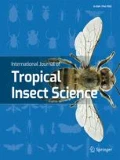Abstract
A cotton field was used to set up an arena trial for investigating the dose transfer of oil-based ultra-low-volume sprays of Metarhizium anisopliae (Metchnikoff) Sorokin to the cotton bollworm Helicoverpa armigera (Hübner). Two doses of conidia (75 and 50g/ha, being 3.75 × 10 and 2.5 × 1012 conidia/ha, respectively) formulated in 2 litres (70:30, kerosene-peanut oil) were applied using a Berthoud ‘Micro Ulva’ to three groups of larvae of cotton bollworms positioned in three rows downwind of a single spray line. Both the distribution of the droplets and the effect of direct contact with spray droplets were quantified. The mean number of droplets decreased from 416 (± 60) droplets per cm2 (line 1;0.4m) to 45 (±36) droplets per cm2 (line 3; 5 m). To achieve 50% mortality, >10 and >13 days were necessary for 75 and 50g/ha, respectively. From day 15, the difference in mortality rates was significant between the two treatments. At line 3 (5 m), at 12 days after application, the mortality rate reached 52% for 75g/ha and 47% for 50g/ha. Fhe results are discussed in view of optimizing the application of the biopesticides.
Similar content being viewed by others
References
Bateman R. P. (1993) Simple, standardised methods for recording droplet measurements and estimation of deposits from controlled droplet applications. Crop Protection 12, 201–206.
Bateman R. P. (1997) Methods of application of microbial pesticide formulations for the control of locusts and grasshoppers. Memoirs of the Entomological Society of Canada 171, 69–81.
Bateman R. P., Douro-Kpindu O. K., Kooyman C., Lomer C. and Ouambama Z. (1998) Some observations on the dose transfer of mycoinsecticide sprays to desert locusts. Crop Protection 17, 151–158.
Bateman R. P., Godonou I., Douro Kpindou O. K., Lomer C. J. and Paraiso A. (1992) Development of a novel “field bioassay” technique for assessing mycopesticide U.L.V. formulations, pp. 255–262. In Biological Control of Locusts and Grasshoppers (edited by C. J. Lomer and C. Prior). CAB International, Wallingford.
Bateman R. P., Price R. F., Müller E. J. and Brown H. D. (1994) Controlling brown locust hopper bands in South Africa with a myco-insecticide spray, pp. 609–616. Proceedings of Brighton Crop Protection Conference — Pest and Diseases, 16–19 November 1994, Brighton, UK.
Bateman R. P. and Thomas M. (1996) Pathogen application against locusts and grasshoppers: insecticide or biological control? Antenna 20, 10–15.
Cherry A., Jenkins N, Heviefo G., Bateman R. P. and Lomer C. (1999) A West African pilot scale production plant for aerial conidia of Metarhizium sp. for use as a mycoinsecticide against locusts and grasshoppers. Biocontrol Science and Technology 9, 35–51.
Douro Kpindou O. K., Djegui D. A., Glitho I. A. and Tamò M. (2010) Réponse des stades larvaires de Helicoverpa armigera (Hübner) (Lepidoptera: Noctuidae) à différentes doses d’application des champignons entomopathogènes Metarhizium anisopliae et Beauveria bassiana. Biotechnologie Agronomie et Environnement.
Douro-Kpindou O.-K., Godonou I., Houssou A., Lomer C. J. and Shah P. A. (1995) Control of Zonocerus variegatus with ULV formulation of Metarhizium flavoviride conidia. Biocontrol Science and Technology 5, 131–139.
Hewitt H. G., Caseley J., Copping L. G., Grayson B. T. and Tyson D. (eds) (1994) Comparing glasshouse and field pesticide performance 11, British Crop Protection Council Monograph No. 59}. 323 pp.
Kulkarni S. A., Ghormade V., Kulkarni G., Kapoor M., Chavan S. B., Rajendran A., Patil S. K., Shouche Y. and Deshpande M. V. (2008) Comparison of Metarhizium isolates for biocontrol of Helicoverpa armigera (Lepidoptera: Noctuidae) in chickpea. Biocontrol Science and Technology 18, 809–828.
Kumar V. and Chowdhry P. N. (2004) Virulence of entomopathogenic fungi Beauveria bassiana and Metarhizium anisopliae against tomato fruit borer, Helicoverpa armigera. Indian Phytopathological Society 54, 208–212.
Langewald J., Thomas M. B., Douro Kpindou O. K. and Lomer C. J. (1997) Use of Metarhizium flavoviride for control of Zonocerus variegatus: a model, linking dispersal and secondary infection from the spray residue with mortality in caged field samples. Entomologia Experimentalis et Applicata 82, 1–8.
Lomer C. J., Bateman R. P., Godonou I., Douro Kpindou O. K, Shah P. A., Paraiso A. and Prior C. (1993) Field infection of Zonocerus variegatus following application of an oil-based formulation of Metarhizium flavoviride conidia. Biocontrol Science and Technology 3, 337–346.
Matthews G. A. (1992) Pesticide Application Methods, 2nd edn. Longmans, Harlow. 405 pp.
SAS (2002–2008). SAS® 9.2, Copyright © 2002–2008 by SAS Institute Inc., Cary, NC, USA.
Staniland L. N. (1959) Fluorescent tracer for the study of spray and dust deposits. Journal of Agricultural Engineering Research 4, 42–81.
Symmons P. M., Dobson H. M. and Sissoko M. (1991) Pesticide droplet size and efficacy: a series of trials on grasshoppers. Crop Protection 10, 136–144.
Teakle R. E. and Jensen J. M. (1985) Heliothis punctigera, pp. 313–322. In Handbook of Insect Rearing (edited by P. Singh and R. F. Moore). Elsevier, Amsterdam.
Thomas M. B., Wood S. N. and Lomer C. J. (1995) Biological control of locusts and grasshoppers using a fungal pathogen: the importance of secondary cycling. Proceedings of the Royal Society London (B) 259, 265–270.
Author information
Authors and Affiliations
Corresponding author
Rights and permissions
About this article
Cite this article
Douro Kpindou, O.K., Djegui, D.A., Glitho, I.A. et al. Dose transfer of an oil-based formulation of Metarhizium anisopliae (Hypocreales: Clavicipitaceae) sprays to cotton bollworm in an arena trial. Int J Trop Insect Sci 31, 262–268 (2011). https://doi.org/10.1017/S1742758411000361
Accepted:
Published:
Issue Date:
DOI: https://doi.org/10.1017/S1742758411000361




